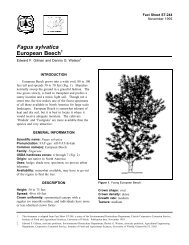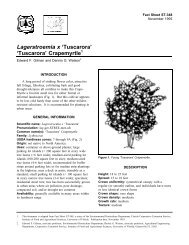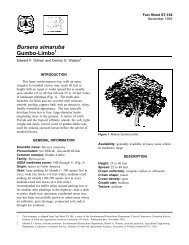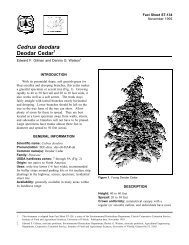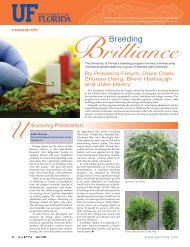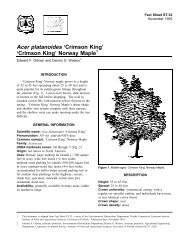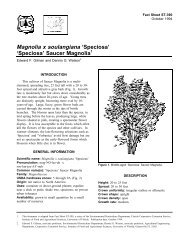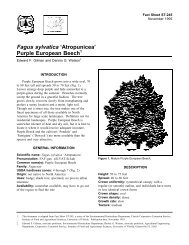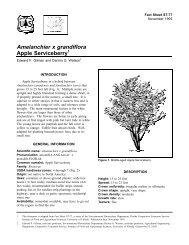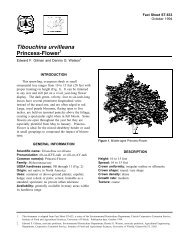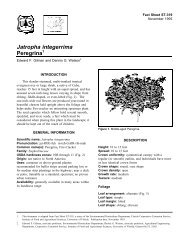Acer saccharinum 'Skinneri' 'Skinneri' Silver Maple - Environmental ...
Acer saccharinum 'Skinneri' 'Skinneri' Silver Maple - Environmental ...
Acer saccharinum 'Skinneri' 'Skinneri' Silver Maple - Environmental ...
Create successful ePaper yourself
Turn your PDF publications into a flip-book with our unique Google optimized e-Paper software.
<strong>Acer</strong> <strong>saccharinum</strong> ‘Skinneri’<br />
‘Skinneri’ <strong>Silver</strong> <strong>Maple</strong> 1<br />
Edward F. Gilman and Dennis G. Watson 2<br />
INTRODUCTION<br />
‘Skinneri’ <strong>Silver</strong> <strong>Maple</strong> is a fast-growing, weakwooded<br />
tree which probably reaches a height of about<br />
60 feet with a large trunk (Fig. 1). It has a somewhat<br />
weeping, pyramidal growth form and the leaves are<br />
finely dissected, not resembling <strong>Silver</strong> <strong>Maple</strong> at all.<br />
Leaves almost appear as if they were injured with a<br />
herbicide because they are so finely dissected. The<br />
tree is useful in wet areas, transplants easily and can<br />
grow where few others can grow. It should be saved<br />
for planting in wet areas or where nothing else will<br />
thrive. Roots often grow on the surface of the soil<br />
making mowing grass difficult under the canopy. It is<br />
also hard to plant shrubs and other plants beneath the<br />
canopy due to the dense root system.<br />
GENERAL INFORMATION<br />
Scientific name: <strong>Acer</strong> <strong>saccharinum</strong> ‘Skinneri’<br />
Pronunciation: AY-ser sack-uh-RYE-num<br />
Common name(s): ‘Skinneri’ <strong>Silver</strong> <strong>Maple</strong><br />
Family: <strong>Acer</strong>aceae<br />
USDA hardiness zones: 3B through 9 (Fig. 2)<br />
Origin: native to North America<br />
Uses: reclamation plant; shade tree; tree has been<br />
successfully grown in urban areas where air pollution,<br />
poor drainage, compacted soil, and/or drought are<br />
common<br />
Availability: somewhat available, may have to go out<br />
of the region to find the tree<br />
Figure 1. Young ‘Skinneri’ <strong>Silver</strong> <strong>Maple</strong>.<br />
DESCRIPTION<br />
Fact Sheet ST-50<br />
November 1993<br />
Height: 50 to 60 feet<br />
Spread: 40 to 60 feet<br />
Crown uniformity: irregular outline or silhouette<br />
Crown shape: pyramidal; weeping<br />
Crown density: moderate<br />
Growth rate: fast<br />
Texture: fine<br />
1. This document is adapted from Fact Sheet ST-50, a series of the <strong>Environmental</strong> Horticulture Department, Florida Cooperative Extension Service,<br />
Institute of Food and Agricultural Sciences, University of Florida. Publication date: November 1993.<br />
2. Edward F. Gilman, associate professor, <strong>Environmental</strong> Horticulture Department; Dennis G. Watson, associate professor, Agricultural Engineering<br />
Department, Cooperative Extension Service, Institute of Food and Agricultural Sciences, University of Florida, Gainesville FL 32611.
<strong>Acer</strong> <strong>saccharinum</strong> ‘Skinneri’ -- ‘Skinneri’ <strong>Silver</strong> <strong>Maple</strong> Page 2<br />
Figure 2. Shaded area represents potential planting range.<br />
Foliage<br />
Leaf arrangement: opposite/subopposite (Fig. 3)<br />
Leaf type: simple<br />
Leaf margin: parted<br />
Leaf shape: star-shaped<br />
Leaf venation: palmate<br />
Leaf type and persistence: deciduous<br />
Leaf blade length: 4 to 8 inches; 2 to 4 inches<br />
Leaf color: green<br />
Fall color: yellow<br />
Fall characteristic: showy<br />
Flower<br />
Flower color: red<br />
Flower characteristics: showy; spring flowering<br />
Fruit<br />
Fruit shape: elongated<br />
Fruit length: 1 to 3 inches<br />
Fruit covering: dry or hard<br />
Fruit color: brown; green<br />
Fruit characteristics: does not attract wildlife; fruit,<br />
twigs, or foliage cause significant litter; showy<br />
Trunk and Branches<br />
Trunk/bark/branches: bark is thin and easily<br />
damaged from mechanical impact; droop as the tree<br />
grows, and will require pruning for vehicular or<br />
pedestrian clearance beneath the canopy; not<br />
particularly showy; should be grown with a single<br />
leader; no thorns<br />
Pruning requirement: requires pruning to develop<br />
strong structure<br />
Breakage: susceptible to breakage either at the crotch<br />
due to poor collar formation, or the wood itself is<br />
weak and tends to break<br />
Current year twig color: brown; reddish<br />
Current year twig thickness: medium; thin<br />
Wood specific gravity: 0.47<br />
Culture<br />
Light requirement: tree grows in part shade/part sun;<br />
tree grows in full sun<br />
Soil tolerances: clay; loam; sand; acidic; extended<br />
flooding; well-drained<br />
Drought tolerance: high<br />
Aerosol salt tolerance: moderate<br />
Soil salt tolerance: moderate
<strong>Acer</strong> <strong>saccharinum</strong> ‘Skinneri’ -- ‘Skinneri’ <strong>Silver</strong> <strong>Maple</strong> Page 3<br />
Figure 3. Foliage of ‘Skinneri’ <strong>Silver</strong> <strong>Maple</strong>.<br />
Other<br />
Roots: surface roots can lift sidewalks or interfere<br />
with mowing<br />
Winter interest: no special winter interest<br />
Outstanding tree: not particularly outstanding<br />
Invasive potential: seeds itself into the landscape<br />
Verticillium wilt susceptibility: susceptible<br />
Pest resistance: long-term health usually not<br />
affected by pests<br />
USE AND MANAGEMENT<br />
<strong>Silver</strong> <strong>Maple</strong> will grow in areas which have<br />
standing water for several weeks at a time. It grows<br />
best on acid soil which remains moist, but adapts to<br />
very dry, alkaline soil. Leaves may scorch in areas<br />
with restricted soil space during dry spells in the<br />
summer but will tolerate drought if roots can grow<br />
unrestricted into a large soil volume.<br />
Like many other large trees, it will lift sidewalks if<br />
improperly located too close to sidewalks. Locate well<br />
away from septic tanks and drain fields since roots<br />
extend about three times the distance from the trunk to<br />
the edge of the branches. There are too many other<br />
superior trees to warrant wide use of this tree,<br />
particularly in urban areas. <strong>Silver</strong> <strong>Maple</strong> is best saved<br />
for wet sites or for naturalizing in an area away from<br />
urban structures. If you must plant a <strong>Silver</strong> <strong>Maple</strong>,<br />
this is one of the nicest.<br />
<strong>Silver</strong> <strong>Maple</strong> is notorious for developing weak<br />
branch crotches and the wood is brittle. Be sure to<br />
prune major limbs so they remain less than half the<br />
diameter of the trunk. This will make the structure<br />
stronger and help the tree to live longer.<br />
Pests<br />
Gall mites can stimulate the formation of growths<br />
or galls on the leaves. The galls are small but can be<br />
so numerous that individual leaves curl up. The most<br />
common gall is bladder gall mite found on <strong>Silver</strong><br />
<strong>Maple</strong>. The galls are round and at first green but later<br />
turn red, then black, then dry up. Galls of other<br />
shapes are seen less frequently on other types of<br />
maples. Galls are not serious, so chemical controls are<br />
not needed.<br />
Crimson erineum mite is usually found on <strong>Silver</strong><br />
<strong>Maple</strong> and causes the formation of red fuzzy patches<br />
on the lower leaf surfaces. The problem is not serious<br />
so control measures are not suggested.<br />
Aphids infest maples, usually Norway <strong>Maple</strong>, and<br />
may be numerous at times. High populations can<br />
cause leaf drop. Another sign of heavy aphid<br />
infestation is honey dew on lower leaves and objects<br />
beneath the tree. Aphids are controlled by spraying or<br />
they may be left alone. If not sprayed, predatory<br />
insects will bring the aphid population under control.<br />
Scales are an occasional problem on maples.<br />
Perhaps the most common is cottony maple scale. The<br />
insect forms a cottony mass on the lower sides of<br />
branches. Scales are usually controlled with<br />
horticultural oil sprays. Scales may also be controlled<br />
with well-timed sprays to kill the crawlers.<br />
If borers become a problem it is an indication the<br />
tree is not growing well. Controlling borers involves<br />
keeping trees healthy. Chemical controls of existing<br />
infestations are more difficult. Proper control involves<br />
identification of the borer infesting the tree then<br />
applying insecticides at the proper time.<br />
There are many others insect problems which can<br />
affect <strong>Silver</strong> <strong>Maple</strong>.
<strong>Acer</strong> <strong>saccharinum</strong> ‘Skinneri’ -- ‘Skinneri’ <strong>Silver</strong> <strong>Maple</strong> Page 4<br />
Diseases<br />
Anthracnose is more of a problem in rainy<br />
seasons. The disease resembles, and may be confused<br />
with, a physiological problem called scorch. The<br />
disease causes light brown or tan areas on the leaves.<br />
Anthracnose may be controlled by fungicides sprayed<br />
on as leaves open in the spring. Two additional sprays<br />
at two-week intervals will be needed. The disease is<br />
most common on sugar and <strong>Silver</strong> <strong>Maple</strong>s and<br />
boxelder. Other maples may not be affected as<br />
severely. Sprays may need to be applied by a<br />
commercial applicator having proper spray equipment.<br />
Verticillium wilt symptoms are wilting and death<br />
of branches. Infected sapwood will be stained a dark<br />
or olive green but staining can’t always be found. If<br />
staining can not be found do not assume the problem<br />
is not verticillium wilt. Severely infected trees<br />
probably can’t be saved. Lightly infected trees<br />
showing only a few wilted branches may be pulled<br />
through. Fertilize and prune lightly infected trees.<br />
This treatment will not cure the problem but may<br />
allow the tree to outgrow the infection. Girdling roots<br />
will cause symptoms which mimic verticillium wilt.<br />
Scorch occurs during periods of high temperatures<br />
accompanied by wind, particularly in areas with<br />
limited soil space where roots cannot expand into a<br />
large soil volume. Trees with diseased or inadequate<br />
root systems will also show scorching. When trees do<br />
not get enough water they scorch. Scorch symptoms<br />
are light brown or tan dead areas between leaf veins<br />
and at the tips of the leaf. The symptoms are on all<br />
parts of the tree or only on the side exposed to sun<br />
and wind. Scorching due to dry soil may be prevented<br />
by watering. If scorching is due to an inadequate or<br />
diseased root system, watering may have no effect.<br />
Nutrient deficiency symptoms are yellow or<br />
yellowish-green leaves with darker green veins. The<br />
most commonly deficient nutrient on maple is<br />
manganese. Implanting capsules containing a<br />
manganese source in the trunk will alleviate the<br />
symptoms. Test soil samples to determine if the soil<br />
pH is too high for best manganese availability. Plants<br />
exposed to weed killers may also show similar<br />
symptoms.



